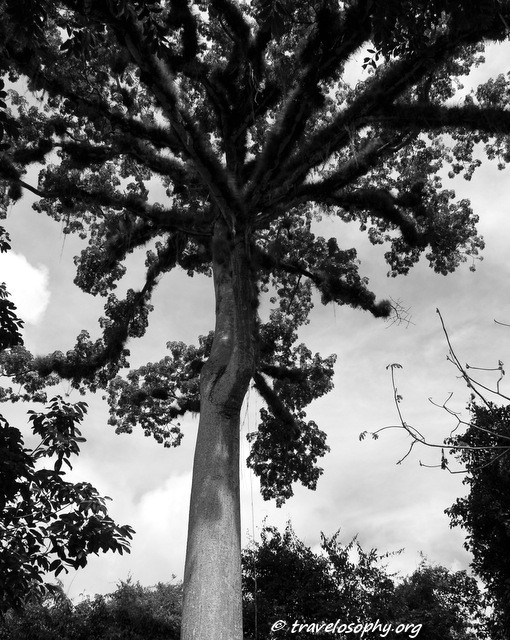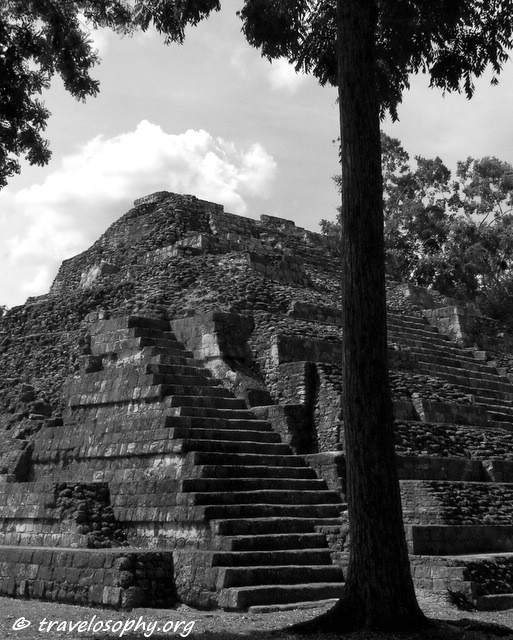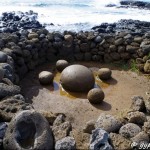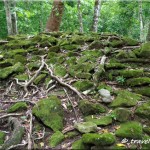
In Mesoamerican theology, the sacred World Tree stands in the centre of the world, vertically connecting three horizontal levels – namely, the heavens above, the earth in the middle and the underworld below. It has its roots embedded deep in the underworld, with its trunk straight and sturdy in the earthly realm and its branches high up in the heavens diverging into the four cardinal directions. Each direction has a colour – east is red, west is black, north is white and south is yellow [1]. The trunk is situated in the centre and has the colour green [2], or blue-green [3]. When viewed from above, this ancient pattern – known as a quincunx – forms a cross that has four directional points and a centre point.
In Maya mythology, everything originally sprouted and emanated from the World Tree. It is the original source – the Tree of Life. The World Tree allowed human souls to come to be. This is symbolised by the white flowers of the majestic Ceiba tree still found in Central America today. The physical bodies that human souls reside in allow them to pass through this life here on earth. All souls come from one of the four cardinal directions, defining not only their characteristics and personality traits, but also their general destiny.
After death, souls would journey along the roots of the World Tree to the Maya underworld, known as Xibalba, a place of fear, decay and disease [4]. Here, they would be challenged and tested for some time before they could reach a place of eternal rest in the afterlife (although some would have to remain behind for an eternity). This process, according to mythology, was unavoidable. All souls would have to make this journey, except for children who died in infancy and adults who unexpectedly experienced sudden or violent deaths. Maya ancestors could use the same route back along the roots of the World Tree to visit the living on special occasions, since the roots are portals from – and to – the underworld.

The underworld had nine gradually descending levels occupied and presided over by various Lords of Death [5]. However, unlike the Western concept of hell, the Maya underworld is also a symbol of being a primordial source – the roots of the World Tree grow from the underworld. All three levels – the underworld, the earth and the heavens – remain connected to each other through the World Tree which is a conduit of communication between the supernatural worlds and the earthly plane.
In Maya cosmology, there were originally just two realms, i.e. the heavens and the underworld. But at a certain date in time, the creator gods, known as Heart of Sky and Heart of Earth, made a decision to raise the sky and create the physical earthly realm in-between [6], setting the ground for souls to be able to experience this intermediate world. At the foot of the World Tree, a crocodile or water turtle is usually depicted, symbolising the surfacing of land out of the primordial waters.
The World Tree is the central pillar holding up the sky, while the four cardinal directions that the tree branches out into are considered to be additional pillars – and so there are five pillars supporting the sky, with the World Tree being in the centre. (To visualise this from above, think of the side of a throwing dice or a domino chip that has five dots or pips on it.)
The Long Count calendar of the classic Maya civilisation measures each of its world ages – known as Great Cycles – as having a duration of 5,125 (Gregorian) years. According to many Maya timekeepers and scholars, four Great Cycles have been completed so far, with the fourth one having ended at the end of 2012. Each one of these world ages had a direction in line with one of the four cardinal directions, but the (current, new) Fifth World is positioned in the centre [3]. As we already know, the Maya World Tree symbolises the centre, where everything comes from and where everything returns to.

In Maya mythology, the world was destroyed or partially destroyed during or after the end of each Great Cycle – and before a new one was created [7]. Another interpretation was that the sky of the old era would descend at its end (the sky would “fall,” because the pillars holding it up would be destroyed) and that a new one would be raised afterwards; however, for the new sky to be raised, sacrifice had to be made [8][9][10].
Outside Maya circles, these concepts gave rise to a huge amount of cataclysmic predictions and prophecies about the literal end of the world, but the above symbolism was not necessarily meant to be taken completely literally. Symbolically speaking, there would be huge societal and cultural changes each time that there is a transition between Great Cycles.
History has, in fact, proven the Maya to be very accurate in forecasting some events. These predictions generally refer to energetic shifts affecting the human mind and consciousness, which then result in societal and cultural changes – while they could sometimes also manifest as physical, earthly changes. Ancient history, biblical scriptures and the mythology of many civilisations point to great environmental cataclysms that had occurred in ancient time, and when consulting actual time frames it would seem that some of them might, indeed, have happened at the end of previous Great Cycles. Such events cannot, therefore, be ruled out today either, especially considering the obvious ongoing effects of global environmental destruction and climate change (whether man-made or natural).
Evolution expanded during the four previous worlds into a different cardinal direction each time with each age representing the energetic characteristics of its direction. The elements of Water, Earth, Air and Fire have all been passed through. The current Great Cycle, the one that only just recently started (post-2012), is said to contain the element of Ether, and this energy will grow gradually over time.
As stated before, the new energy flow is towards the symbolic centre during the Fifth World. This would eventually lead to a harmonisation [11] and a balancing of the previous evolutionary movements, reaching a blend of the four previous energies with a new one – Ether – added to the mix.
What this would mean [12] in reality would have to be experienced over time to know, but according to wise Maya spiritual leaders and the prophecies of indigenous groups in the Americas – such as the Hopis and the Mayans – we are meant to be co-creators during this process in line with our personal energetic traits and characteristics (as defined by Maya cosmology [13]).
This could be extrapolated upon by suggesting that, in order to be active participants, we would need to get to know ourselves much better (for details, please see: The Keys to Conscious Co-Creation); the reason being is that during this new world age everything will be returning to its own unique core. This is where the connection to the metaphysical Universal Centre resides – and that would also be relevant to us – and so, we humans will be prompted to return to our core-Selves, too.
There are two aspects to this new paradigm. First, the universe is naturally facilitating this movement by our entering of the Fifth World which is energetically situated in the centre of the metaphysical World Tree – which means that this is increasingly the very nature of the times in which we currently live. Second, the expectation of people being co-creators means that we can meet the universe halfway during this process. We can actively engage in knowing ourselves better through introspection and reflection, combined with acknowledgment and correction, which would guide us to act in accordance with our authentic higher-Selves.
There will, inevitably, have to be some personal sacrifices along the way, and the most difficult of these would be the hardest sacrifice of all – namely, sacrificing the vanity of the ego [8] and replacing that with humility. By doing so, we would open the door for the return of a part of our consciousness that we have lost – the consciousness of that which is sacred [14]. Returning to this lost consciousness can ultimately lead us back to reconnecting, and being in harmony, with the original Source of Life – the Universal Centre and the Tree of Life – which connects all centres with each other and connects them with Itself.
By J.J. Montagnier (First Published: 12 October, 2015; Updated on 20 April, 2020)
Additional notes: The concept of the Maya underworld is compatible with the Jungian concept of the Collective Unconscious, which underlies all individual consciousness. In a Jungian sense, the underworld is equivalent to the subconscious (also known as the unconscious), the earthly plane could be considered everyday consciousness, and the heavens would relate to having arrived at higher levels of awareness and consciousness.
Recommended Follow-up article:
Preparing for the Hero’s Journey (Oct 2020)
Related essays:
Energy Shifts (series)
Darkness Before Dawn (series)
Bibliography:
[1] It is the book of our Elders. It told how Sky and Earth were created, quartered into equinoxes and solstices. Divided into four parts, the directions: Red, the East; Black, the West; White, the North; and Yellow, the South.
Barrios, C. (2009): “The Book of Destiny: Unlocking the Secrets of the Ancient Mayans and the Prophecy of 2012”. HarperCollins, P. 47, Line 12
[2] Colors associated with the quincunx are red in the east, white in the north, black in the west, yellow in the south and green in the center. (2011, July 24)
ThoughtCo. https://www.thoughtco.com/ceiba-pentandra-sacred-tree-maya-171615
[3] A fifth ‘direction’, the ‘center’, also formed a part of this scheme. Associated with a blue-green colour, this was most frequently represented by a great Ceiba tree, conceptualized as the ‘tree of life’.
McGill School of Computer Science: https://www.cs.mcgill.ca/~rwest/wikispeedia/wpcd/wp/m/Maya_mythology.htm
[4] The ancient Maya believed that the underworld – Xibalba – was a ‘place of fear’. In other accounts, Xibalba is a place of decay and disease and a destination of human souls after death.
Ancient Pages (20 Feb., 2018): https://www.ancientpages.com/2018/02/20/xibalba-nine-leveled-underground-place-of-fear-ruled-by-lords-of-death-in-maya-beliefs/
[5] This large underground city is organised into nine, gradually descending levels. It contains passages, dark caves and the living spaces occupied by the Lords of Xibalba.
Ancient Pages (20 Feb., 2018): https://www.ancientpages.com/2018/02/20/xibalba-nine-leveled-underground-place-of-fear-ruled-by-lords-of-death-in-maya-beliefs/
[6] Thus was the earth created, when it was formed by the Heart of Heaven, the Heart of Earth, as they are called who first made it fruitful when the sky was in suspense and the earth was submerged in the water.
“The Book of the People: Popol Vuh”, Delia Goetz and Sylvanus Griswold Morley from Adrián Recino’s translation from Quiché into Spanish, Plantin Press, Los Angeles (1954). Pdf version. Part I, Chapter 1, Page 4
[7] According to a shared world view common throughout the Mesoamerican cultural sphere, the world has been created and destroyed a number of times. “Worlds of Emergence”, P. 94
Each cycle grows and develops until its very gifts become difficulties. The world falls out of balance and the gods bring it to an end. “Worlds of Emergence”, P. 95
Munro Edmonson asserted that during period endings, the Yucatec Maya used to have ritual processions in which they carried icons of the World Tree to symbolize that the World Tree was raised at the beginning of every new cycle. “The Chilam Balam Books”, P. 116
Johnson, K. (2012): “The Mayan Prophecies: The Renewal of the World 2012-2072”. Pdf version. Published by Mystical Jaguar Productions, Taos, New Mexico
[8] Note from the writer: In the Mayan Creation Story (the Popol Vuh), a deity named Seven Macaw had to be destroyed due to his pride – he committed the sin of “self-magnifying” and this was seen to be evil. This happened in the era of ‘the wooden men’ at the end of the Third World. This meant that Seven Macaw’s ego had to be sacrificed before a new world, the Fourth World, could be created – before the Sky of the Fourth World could be raised by raising the new World Tree. It’s worth bearing in mind that Mayan mythology and cosmology are intertwined, and the story lines also suggest celestial movements. (J.J. Montagnier)
[9] Seven Macaw is knocked from his perch atop the World Tree. Dennis Tedlock reports that among the Quiche Maya, the mid-summer descent of the Dipper just after sunset marks the beginning of the hurricane season, the time of flooding. The sky of the old order fell when Seven Macaw was knocked from his perch and the deluge destroyed the wooden people. The sky of the new world could only be raised by an act of sacrifice.
“The hearth stones of creation”. (n.d.). The Book of Threes – All Things Three: https://bookofthrees.com/mayan-culture-the-hearth-stones-of-creation/
[10] But there was one who magnified himself; Seven Macaw is his name. The sky-earth was already there, but the face of the sun-moon was clouded over. Even so, it is said that his light provided a sign for the people who were flooded. He was like a person of genius in his being. “I am great. My place is now higher than that of the human work, the human design. I am their sun and I am their light, and I am also their months. So be it: my light is great. I am the walkway and I am the foothold of the people, because my eyes are of metal. My teeth just glitter with jewels, and turquoise as well; they stand out blue with stones like the face of the sky.”
Tedlock, D. (2013): “Popol Vuh: The Mayan Book of the Dawn of Life and the Glories of Gods and Kings”, TaleBooks.com. Pdf. P. 43, line 14
And so, Seven Macaw puffs himself up as the days and the months, though the light of the sun and moon has not yet clarified. He only wished for surpassing greatness. This was when the flood was worked upon the manikins, woodcarvings. Tedlock, D. (2013)
Tedlock, D. (2013):“Popol Vuh: The Mayan Book of the Dawn of Life and the Glories of Gods and Kings”, TaleBooks.com. Pdf. P. 43, line 36
[11] December 21, 2012 is the pivotal date that everyone has heard of. According to our tradition, this is the period when Job Ajaw, or the Fifth Sun, is expected to begin. This period is of great importance because it will be a time when humans ascend to a harmonious, spiritual level.
Barrios, C. (2009): “The Book of Destiny: Unlocking the Secrets of the Ancient Mayans and the Prophecy of 2012”, HarperCollins, P. 120. Line 17
[12] The Fifth Sun is a time of harmony, peace, tolerance and balance. It ushers in a new framework that will modify the current socioeconomic system.
Barrios, C. (2009): “The Book of Destiny: Unlocking the Secrets of the Ancient Mayans and the Prophecy of 2012”, HarperCollins, P. 123, Line 6
[13] http://www.mayancross.com/
[14] Maya religious beliefs are formed on the notion that virtually everything in the world contains k’uh, or sacredness. K’uh and k’uhul, similar terms which are used to explain the spirituality of all inanimate and animate things, describe the most divine life force of existence. Maya belief establishes the creation and sanctity of human beings, the earth, and all things sacred. This divine sanctity can be translated into Maya creation myths as well.
Gomez, M. (2020, April 19): Maya Religion. Retrieved: April 19, 2020 from http://www.ancient.eu/Maya_Religion/
Copyright 2015 / 2020 © · All Rights Reserved · GypsyCafe.org


14 Comments
Thank you for this offering that brings greater understanding of the world tree and the dimensions relevant to the elementals. in lak’ech JW
Thank you for reading, Jaguar Woman. Blessings from South America.
Thank you for clarifying what this brand new age is supposed to be about. Interestingly, your description of moving back to the center and harmonizing previous expansions seems to be in line with what is starting to happen. Recent challenges are forcing us to become more aware of how our actions are affecting the planet and all those who live upon it. From my limited perspective, it seems like there are more people calling for coexistence; both with other people and other life forms. It will be interesting to see what sorts of changes are before us.
Thank you very much for sharing your thoughts – and I agree wholeheartedly. It is likely, I think that moving forward we will be faced with many challenges, especially in relation to resource depletion and climate change, while at the same time “the return to centre” will progressively guide us towards coexistence and harmonious living – as you so eloquently expressed. It is very positive indeed to find that more and more people are becoming concerned and aware of the times we live in.
Wow–great article and photos, Jean-Jacque! Excellent info. I was very into Meso-American early civilizations a few years ago–fascinated with the Maya and the Yucatan penninsula. Never been there though. I envy your travel and your log of interesting sites and regional cultures. You do a great service to all of us by sharing your discoveries. Thank you my friend!
Thank you Rebecca – for reading and for your feedback! It’s really great to hear that people are enriched by my postings. Sharing is a community effort for me – one I do with pleasure! 🙂 As long as it can benefit other members (the “community” is undefined btw – anyone who benefits) – and it motivates further travels – especially the current selection of destinations. You should see if you can make it to Guatemala sometime – really worth it – I’m sure you’ll really enjoy it!
I absolutely loved this article. The first few paragraphs, along with the “Additional Notes” reminded me strongly of a movie entitled “The Fountain”. I do believe now that the director called upon some of this mythology along with the Jungian concept of consciousness to create that film.
The article inspires me to expand on certain pieces of fiction I’ve been working on for a long time as well.
Yet all is not fiction. The deeper meaning of the article is clear — that we must return to our roots, our center. I think this is a necessary message for this “new age” that we are entering into.
Stephen, thank you for your comment! Sorry for the delayed reply. I´m currently in Peru, so I´m online sporadically. Yes, I remember The Fountain – great film. Another such film which connects with the New Age I think is the film Avatar. It´s very possible the directors of these films were also drawing on ancient wisdoms intuitively – and I think that is why it resonated so much with people and also ties in with not everything being fiction – as you said.
Mythology, although seemingly fictional were actually used as highly advanced guidance systems in ancient civilisations. For example in the Maya culture´s most famous book of mythology, the Popol Vuh, there is a “Lord of Death” or “Demon” (I don´t remember the exact details) which used to pester people who didn’t sweep in front of their homes..! We can well imagine how fear of the “sweeping demon” motivated people to sweep very often! And of course it served that function – a subliminal system to motivate people to keep their lives tidy and organised (at least that is my interpretation of it..) – and mythology holds many other functions and more – such as ancient wisdoms and truths, which can be carried forward into the future, generation after generation.
What I learned from the preface of Popol Vuh, for the Mayans words were sacred and they had to be expressed thoughtfully – and their effects or repercussions had to be considered.
I had a discussion a while ago with someone who lives in France, who said to me that if (modern) children were brought up on mythology they would likely be much better prepared for the real world and they would probably be much wiser too.
I very much appreciate your comment and that it inspires you to expand on some of your pieces is humbling and inspiring in return.
A very explanatory information, Thanks a lot for posting
You are welcome. Thank you for reading.
JJ,
Informative and concise. Lots of information here. I wonder about returning to the center and think of centralized power. In his book “Collapse: How Societies Choose to Fail or Succeed,” Jared Diamond says the Mayans failed partly because of deforestation and erosion. Also invasion by Europeans. I also think of the centralized power concept, where, ultimately, all energy is drawn to the center, creating a vortex that implodes.
The other idea of centralization is individualization, the idea of self-sustainment through concentrated personal power. This is consistent with co-operation in that each individual participates voluntarily as an equal. This also supports the idea of the New Age of Aquarius in astrology, the brotherhood of man, opposite the Leo end of the pole, which represents the ego.
Amazing how all these symbolic languages support and reinforce each other.
Katharine – thank you for your reflections and insight – yes, absolutely: as you explained, that is exactly what happens with centralised power – it tends to implode one way or another. The “return to centre” that I am talking about is a multi-level contraction: all individual things will return to its own individual centre. In other words: natural decentralisation. In political-speak we could say a move from uni-polarity to multi-polarity.
I am glad that you honed in on this point, because I think it is important to make a clear distinction.
In relation to the Mayans failing – yes, is true that they made the same errors as us in terms of deforestation and over-exploiting their immediate environment – when I visited Copan in Honduras this was explained on a series of signboards at the archaeological site – I have published some quotes over here:
http://gypsycafe.org/2015/11/01/copan-maya-site-discovery-1/
The Mayans had various city states in the Yucatan and Central American region and they were often in conflict with each other, although I think there was never one unified centralised Mayan state or nation – so for example if one city state failed, others continued.
Something interesting I have learned about the “collapse” of the Mayan civilisation is that they developed their cities on energy centres. Everything was about energy for them – and the cycles of time related to it. When the energy shifted after hundreds or thousands of years out of their cities, they would abandon them and would return to agricultural lifestyles until they found new energy centres to build new cities upon – this sometimes took a hundred years or more. From a Western perception it may look like an inexplicable collapse… because we would never dream of abandoning our infrastructure for the countryside, because “the energy shifted”.
Also, they understood that all civilisation rise and fall and everything has its time, so they may not have viewed their own “collapse” as such a disaster – but as you also mentioned, the biggest disaster that befell them was the Spanish invasion. The Conquistadors destroyed virtually all Mayan literature systematically and only a very few books remain. This is the real tragedy – most of the codices that have survived are copies – like the Chilam Balam books that contain the Katun prophecies that I wrote about in the Energy Transitions series.
You are right about so many symbolic languages having similar imagery and messages and I think it points very much to universal archetypes in the collective unconscious as Carl Jung had also identified – and so they appear centuries apart in the artworks and mythologies of people at different ends of the planet. Truly fascinating!
Pingback: (2) The Valley of Shadows in the Landscape of Light – Energy Shifts
Pingback: (0) The Maya World Tree – Energy Shifts